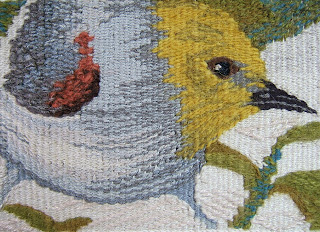
They are very enjoyable to watch as they are very active, climbing & hopping nimbly & acrobatically around in dense vegetation in search of bugs. They nest in the prickliest of desert plants, including cholla cactus.
The birds I am choosing for the series are very common here in the Sonoran desert, & often live in close proximity to people's homes.
Unfortunately, many people are unaware of the existence of these birds & the benefits they provide to the environment. When people think they are "cleaning up" their properties by digging up & disposing of what they feel are "undesirable" cactus, such as cholla, prickly pear & other native plant species, leaving large patches of bare soil, they are eradicating a crucial part of this very special desert. Desert plants grow very slowly, they help to hold in moisture & reflect the intense heat, & they are home to many of the birds I plan to depict in this series.
I was inspired to create this series after weaving the first bird, a cactus wren, for a fiber art postcard exhibit held last spring at our local botanical park & museum, Tohono Chul Park. All entries had to be the exact size of a postcard, 4" x 6", & had to be mailed to the museum as actual postcards, sans envelope, box, or wrapper of any sort! I so enjoyed weaving this first small tapestry that the idea of the series was born.....
The cactus wren (Campylorhyncus brunneiecapillus) is one of the largest wrens, between 7" to almost 9" in length. Another insect eater that loves to nest in cholla cactus, it is also Arizona's state bird. They are very active, curious, & intelligent. Their distinctive call, which has been described by some to sound like the "chug, chug, chug" of a car engine trying to start, is heard throughout the desert in the spring.
More birds will be added to the series... I have so many favorites, I'm not sure when the series will end or how many birds will end up in it! It is my hope that seeing these birds will make people stop & think before they make the choice to destroy the desert where these birds live.



No comments:
Post a Comment